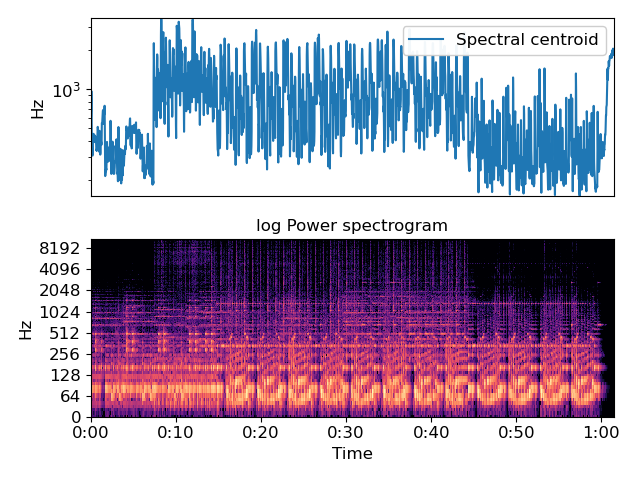Caution
You're reading an old version of this documentation. If you want up-to-date information, please have a look at 0.9.1.
librosa.feature.spectral_centroid¶
- librosa.feature.spectral_centroid(y=None, sr=22050, S=None, n_fft=2048, hop_length=512, freq=None, win_length=None, window='hann', center=True, pad_mode='reflect')[source]¶
Compute the spectral centroid.
Each frame of a magnitude spectrogram is normalized and treated as a distribution over frequency bins, from which the mean (centroid) is extracted per frame.
More precisely, the centroid at frame t is defined as [1]:
centroid[t] = sum_k S[k, t] * freq[k] / (sum_j S[j, t])where S is a magnitude spectrogram, and freq is the array of frequencies (e.g., FFT frequencies in Hz) of the rows of S.
- 1
Klapuri, A., & Davy, M. (Eds.). (2007). Signal processing methods for music transcription, chapter 5. Springer Science & Business Media.
- Parameters
- ynp.ndarray [shape=(n,)] or None
audio time series
- srnumber > 0 [scalar]
audio sampling rate of y
- Snp.ndarray [shape=(d, t)] or None
(optional) spectrogram magnitude
- n_fftint > 0 [scalar]
FFT window size
- hop_lengthint > 0 [scalar]
hop length for STFT. See
librosa.core.stftfor details.- freqNone or np.ndarray [shape=(d,) or shape=(d, t)]
Center frequencies for spectrogram bins. If None, then FFT bin center frequencies are used. Otherwise, it can be a single array of d center frequencies, or a matrix of center frequencies as constructed by
librosa.core.ifgram- win_lengthint <= n_fft [scalar]
Each frame of audio is windowed by window(). The window will be of length win_length and then padded with zeros to match n_fft.
If unspecified, defaults to
win_length = n_fft.- windowstring, tuple, number, function, or np.ndarray [shape=(n_fft,)]
a window specification (string, tuple, or number); see
scipy.signal.get_windowa window function, such as
scipy.signal.hanninga vector or array of length n_fft
- centerboolean
If True, the signal y is padded so that frame t is centered at y[t * hop_length].
If False, then frame t begins at y[t * hop_length]
- pad_modestring
If center=True, the padding mode to use at the edges of the signal. By default, STFT uses reflection padding.
- Returns
- centroidnp.ndarray [shape=(1, t)]
centroid frequencies
See also
librosa.core.stftShort-time Fourier Transform
librosa.core.ifgramInstantaneous-frequency spectrogram
Examples
From time-series input:
>>> y, sr = librosa.load(librosa.util.example_audio_file()) >>> cent = librosa.feature.spectral_centroid(y=y, sr=sr) >>> cent array([[ 4382.894, 626.588, ..., 5037.07 , 5413.398]])
From spectrogram input:
>>> S, phase = librosa.magphase(librosa.stft(y=y)) >>> librosa.feature.spectral_centroid(S=S) array([[ 4382.894, 626.588, ..., 5037.07 , 5413.398]])
Using variable bin center frequencies:
>>> y, sr = librosa.load(librosa.util.example_audio_file()) >>> if_gram, D = librosa.ifgram(y) >>> librosa.feature.spectral_centroid(S=np.abs(D), freq=if_gram) array([[ 4420.719, 625.769, ..., 5011.86 , 5221.492]])
Plot the result
>>> import matplotlib.pyplot as plt >>> plt.figure() >>> plt.subplot(2, 1, 1) >>> plt.semilogy(cent.T, label='Spectral centroid') >>> plt.ylabel('Hz') >>> plt.xticks([]) >>> plt.xlim([0, cent.shape[-1]]) >>> plt.legend() >>> plt.subplot(2, 1, 2) >>> librosa.display.specshow(librosa.amplitude_to_db(S, ref=np.max), ... y_axis='log', x_axis='time') >>> plt.title('log Power spectrogram') >>> plt.tight_layout() >>> plt.show()
